【人教版】2017-2018学年七年级英语上册:全一册学案(含答案)
- 格式:docx
- 大小:643.63 KB
- 文档页数:248
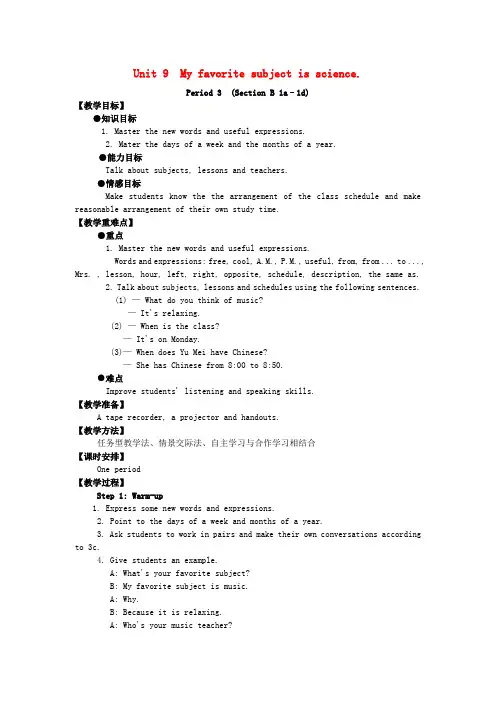
Unit 9 My favorite subject is science.Period 3 (Section B 1a–1d)【教学目标】●知识目标1. Master the new words and useful expressions.2. Mater the days of a week and the months of a year.●能力目标Talk about subjects, lessons and teachers.●情感目标Make students know the the arrangement of the class schedule and make reasonable arrangement of their own study time.【教学重难点】●重点1. Master the new words and useful expressions.Words and expressions: free, cool, A.M., P.M., useful, from, from ... to ..., Mrs. , lesson, hour, left, right, opposite, schedule, description, the same as.2. Talk about subjects, lessons and schedules using the following sentences.(1) — What do you think of music?— It's relaxing.(2) — When is the class?— It's on Monday.(3)— When does Yu Mei have Chinese?— She has Chinese from 8:00 to 8:50.●难点Improve students' listening and speaking skills.【教学准备】A tape recorder, a projector and handouts.【教学方法】任务型教学法、情景交际法、自主学习与合作学习相结合【课时安排】One period【教学过程】Step 1: Warm-up1. Express some new words and expressions.2. Point to the days of a week and months of a year.3. Ask students to work in pairs and make their own conversations according to 3c.4. Give students an example.A: What's your favorite subject?B: My favorite subject is music.A: Why.B: Because it is relaxing.A: Who's your music teacher?B: Mr. Xie.A: When is the class ?B: It's on Wednesday.5. Invite some pairs to act out their conversations.Step 2: PresentationTeach activity 1a1. Lead students to read the adjectives in the two box.2. Ask students to match the words on the left with their opposites on the right.3. Invite one student to tell his\her answers.4. Check the correct answers to the whole class.Step 3: Practice1. Teach activity 1b(1) Ask students to read the words in 1a again and try o recite them.(2) Tell students that they are going to listen to a tape. Check(√) the words they hear in 1a.(3) Invite one student to read his\her answers.(4) Check the correct answers with the whole class.2. Teach activity 1c(1) Lead students to read the schedule.(2) Ask students to listen again and circle the classes David talks about on the schedules.(3) Play the recording for the first time and ask students to try their best to circle the classes they hear.(4) Play the recording for a second time and check the answers.(5) Check the correct answers with the whole class.Step 4: ConsolidationTeach activity 1d1. Ask students to read the conversations in 1d and ask students to fill in the blanks.2. Ask students to work with their partners and talk about David's favorite subject.3. Give students an example.A: What's David's favorite subject?B: Chinese.A: Why does he like Chinese?B: Because it's interesting.A: When is the class?B: It's on Monday, Wednesday, Thursday and Friday.4. Students work in pairs and make their own conversations.5. Ask students to talk about their own favorite subjects and make conversations.6. Invite several pairs to act out their conversations.【课后作业】In this period, we’ve mainly learned how to talk about one’s schedule in aweek and consolidated what we learned in the previous periods.【课后作业】1. Recite the text in Section B, 2b aloud.2. Make a schedule for the week.。
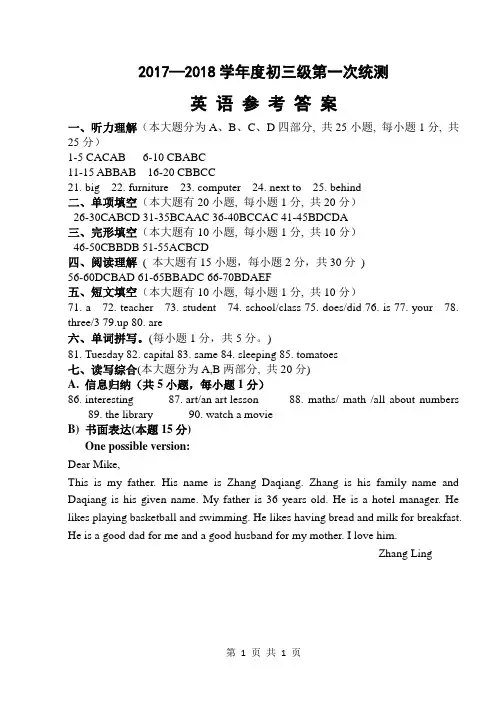
2017—2018学年度初三级第一次统测英语参考答案一、听力理解(本大题分为A、B、C、D四部分, 共25小题, 每小题1分, 共25分)1-5 CACAB 6-10 CBABC11-15 ABBAB 16-20 CBBCC21. big 22. furniture 23. computer 24. next to 25. behind二、单项填空(本大题有20小题, 每小题1分, 共20分)26-30CABCD 31-35BCAAC 36-40BCCAC 41-45BDCDA三、完形填空(本大题有10小题, 每小题1分, 共10分)46-50CBBDB 51-55ACBCD四、阅读理解( 本大题有15小题,每小题2分,共30分)56-60DCBAD 61-65BBADC 66-70BDAEF五、短文填空(本大题有10小题, 每小题1分, 共10分)71. a 72. teacher 73. student 74. school/class 75. does/did 76. is 77. your 78. three/3 79.up 80. are六、单词拼写。
(每小题1分,共5分。
)81. Tuesday 82. capital 83. same 84. sleeping 85. tomatoes七、读写综合(本大题分为A,B两部分, 共20分)A. 信息归纳(共5小题,每小题1分)86. interesting 87. art/an art lesson 88. maths/ math /all about numbers89. the library 90. watch a movieB) 书面表达(本题15分)One possible version:Dear Mike,This is my father. His name is Zhang Daqiang. Zhang is his family name and Daqiang is his given name. My father is 36 years old. He is a hotel manager. He likes playing basketball and swimming. He likes having bread and milk for breakfast. He is a good dad for me and a good husband for my mother. I love him.Zhang Ling第 1 页共1 页。
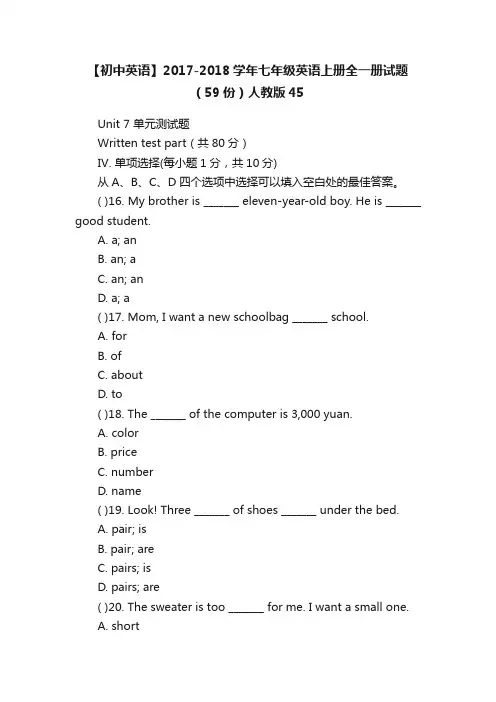
【初中英语】2017-2018学年七年级英语上册全一册试题(59份)人教版45Unit 7 单元测试题Written test part(共80分)Ⅳ. 单项选择(每小题1分,共10分)从A、B、C、D四个选项中选择可以填入空白处的最佳答案。
( )16. My brother is _______ eleven-year-old boy. He is _______ good student.A. a; anB. an; aC. an; anD. a; a( )17. Mom, I want a new schoolbag _______ school.A. forB. ofC. aboutD. to( )18. The _______ of the computer is 3,000 yuan.A. colorB. priceC. numberD. name( )19. Look! Three _______ of shoes _______ under the bed.A. pair; isB. pair; areC. pairs; isD. pairs; are( )20. The sweater is too _______ for me. I want a small one.A. shortB. rightC. bigD. fine( )21. —What’s six and seven?—It’s _______.A. twelveB. thirteenC. fourteenD. fifteen( )22. The apple _______ good. I want to eat it.A. meetsB. watchesC. seesD. looks( )23. I like these baseball bats, and I’ll _______ them.A. sellB. spellC. takeD. play( )24. —Frank, do you _______ any help?—No, thanks.A. needB. askC. knowD. have( )25. —Mary, can I use your dictionary?—Sure. _______.A. I have a dictionaryB. It’s not mineC. I don’t use itD. Here you areⅤ. 完形填空(每小题1分,共10分)先通读下面的短文,掌握其大意,然后从A、B、C、D四个选项中选择可以填入空白处的最佳答案。
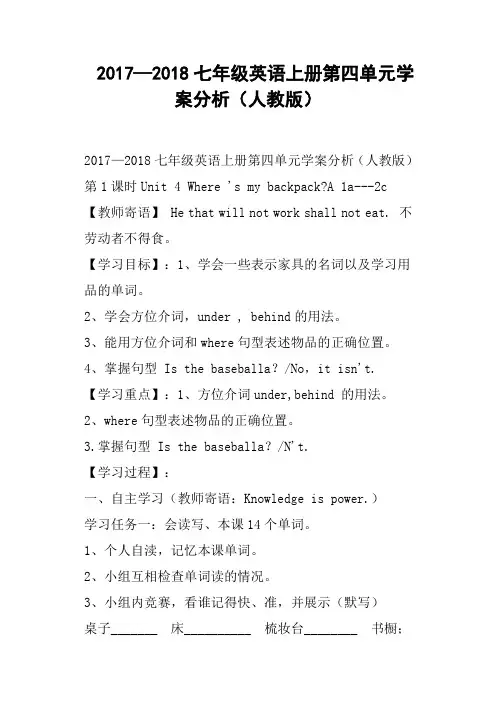
2017—2018七年级英语上册第四单元学案分析(人教版)2017—2018七年级英语上册第四单元学案分析(人教版)第1课时Unit 4 Where 's my backpack?A 1a---2c 【教师寄语】 He that will not work shall not eat. 不劳动者不得食。
【学习目标】:1、学会一些表示家具的名词以及学习用品的单词。
2、学会方位介词,under , behind的用法。
3、能用方位介词和where句型表述物品的正确位置。
4、掌握句型 Is the baseballa?/No,it isn't.【学习重点】:1、方位介词under,behind 的用法。
2、where句型表述物品的正确位置。
3.掌握句型 Is the baseballa?/N't.【学习过程】:一、自主学习(教师寄语:Knowledge is power.)学习任务一:会读写、本课14个单词。
1、个人自渎,记忆本课单词。
2、小组互相检查单词读的情况。
3、小组内竞赛,看谁记得快、准,并展示(默写)桌子_______ 床__________ 梳妆台________ 书橱;书柜_______ 沙发_______椅子________ 抽屉________ 植物_________ (疑问副词)在哪里________在…下_____ 在…上_____ 在…里面___ __ 在…后面___ __他(她,它)们_____5、认真观察1a的图画,将词语与图中物品搭配,小组讨论,并核对答案。
学习任务二:用方位介词描述物品的位置。
1、利用物品的位置变化,练习方位介词in,on ,underbehind以及介词短语(教师示范)。
2、小组为单位练习这些方位介词及短语,并完成下列短语。
在桌子下面__________ 在梳妆台上__________ 在书橱里___________ ___在沙发上____________ 在床下面____________ 在椅子后面____________3、总结:介词短语结构_______________________学习任务三:运用方位介词in,on,under,behind 及where's …?/where are …?及其答语,自由交际,表述物品的正确位置。
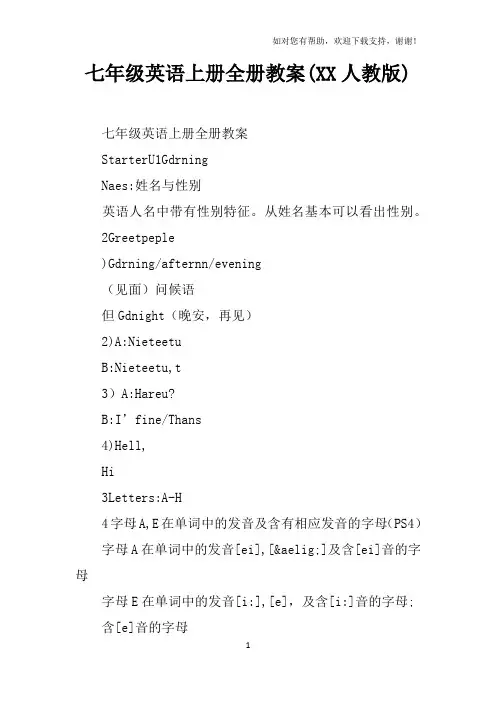
七年级英语上册全册教案(XX人教版)七年级英语上册全册教案StarterU1GdrningNaes:姓名与性别英语人名中带有性别特征。
从姓名基本可以看出性别。
2Greetpeple)Gdrning/afternn/evening(见面)问候语但Gdnight(晚安,再见)2)A:NieteetuB:Nieteetu,t3)A:Hareu?B:I’fine/Thans4)Hell,Hi3Letters:A-H4字母A,E在单词中的发音及含有相应发音的字母(PS4)字母A在单词中的发音[ei],[æ]及含[ei]音的字母字母E在单词中的发音[i:],[e],及含[i:]音的字母;含[e]音的字母StarterU2hat’sthisinEnglish?介绍身边事物及中英文拼写Eg1)A:hat’sthisinEnglish?B:It’sashlbagA:Spellit,pleaseB:s--h---l-b-a-gEg2)A:hat’sthisinEnglish?B:It’sanrangeA:Spellit,pleaseB:-r-a-n-g-eEg3)A:hat’sthatinEnglish?B:It’saaetA:Spellit,pleaseB:-A---E-T补充:1)in表示“用…(语言)”。
Eg:A:hat’sthatinEnglish?B:It’sa床。
另一种表达方式:A:hat’stheEnglishfr电脑?B:It’saputer2不定冠词a和an(泛指一个)元音(发音)开头的字前用an,辅音(发音)开头的字前用aae,aap,apiture,ab,asheepanapple,anrange,anegg,anubrella,anhur,anhnestan,3Letters:I-R4字母A,E,I,在单词中的发音及含有相应发音的字母(PS8)字母I在单词中的发音[ai]、[i],及含[ai]音的字母字母在单词中的发音[əu]、[`],及含[əu]音的字母StarterU3hatlrisit?辨识颜色(颜色名词;有关事务颜色的描述)Eg:red,green,blue,range,ell,pin,purple,bla,hite,gra,brn,2Letters:S-Z3元音字母(A,E,I,,U)与辅音字母4字母A,E,I,,U在单词中的发音及含有相应发音的字母(PS12)字母U在单词中的发音[u:]、[>],及含[u:]音的字母hat疑问句及回答Eg:1)--hat’sthis?--It’saTV2)--hatlrisit?--It’sred6介词in“在…里面”的用法Eg:)Einthe“evening”U1naeisGina自我介绍:姓名:1)I’Gina2)naeisGina注:1)”姓”在后—lastnae,“名”在前—firstnae 年龄:1)Ia12thisear2)I’12earsldthisear2见面问候)Hell/Hi2)Gdrning/afternn/evening3)Nieteet/seeu3相互介绍(认识):询问姓名)hat’sunae?2)urnae,please?3)aInurnae?Eg:A:Hell,I’Ginahat’surnae?B:naeisindA:Hi,indNieteetuB:Nieteetut4电话号码的询问与告知Eg:)A:hat’surtelephnenuber,Gina? B:It’s281-91762)A:hat’shertelephnenuberB:806-224注:1)电话座机号码通常分为两部分2)直接说每个数字,但数字0通常念为字母。
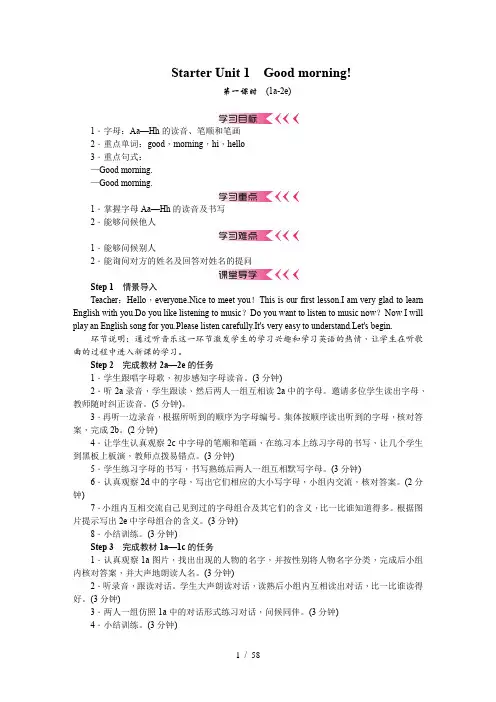
Starter Unit 1Good morning!第一课时(1a2e)1.字母:Aa—Hh的读音、笔顺和笔画2.重点单词:good,morning,hi,hello3.重点句式:—Good morning.—Good morning.1.掌握字母Aa—Hh的读音及书写2.能够问候他人1.能够问候别人2.能询问对方的姓名及回答对姓名的提问Step 1情景导入Teacher:Hello,everyone.Nice to meet you!This is our first lesson.I am very glad to learn English with you.Do you like listening to music?Do you want to listen to music now?Now I will play an English song for you.Please listen carefully.It's very easy to understand.Let's begin.环节说明:通过听音乐这一环节激发学生的学习兴趣和学习英语的热情,让学生在听歌曲的过程中进入新课的学习。
Step 2完成教材2a—2e的任务1.学生跟唱字母歌,初步感知字母读音。
(3分钟)2.听2a录音,学生跟读,然后两人一组互相读2a中的字母。
邀请多位学生读出字母,教师随时纠正读音。
(5分钟)。
3.再听一边录音,根据所听到的顺序为字母编号。
集体按顺序读出听到的字母,核对答案,完成2b。
(2分钟)4.让学生认真观察2c中字母的笔顺和笔画,在练习本上练习字母的书写,让几个学生到黑板上板演,教师点拨易错点。
(3分钟)5.学生练习字母的书写,书写熟练后两人一组互相默写字母。
(3分钟)6.认真观察2d中的字母,写出它们相应的大小写字母,小组内交流,核对答案。
(2分钟)7.小组内互相交流自己见到过的字母组合及其它们的含义,比一比谁知道得多。
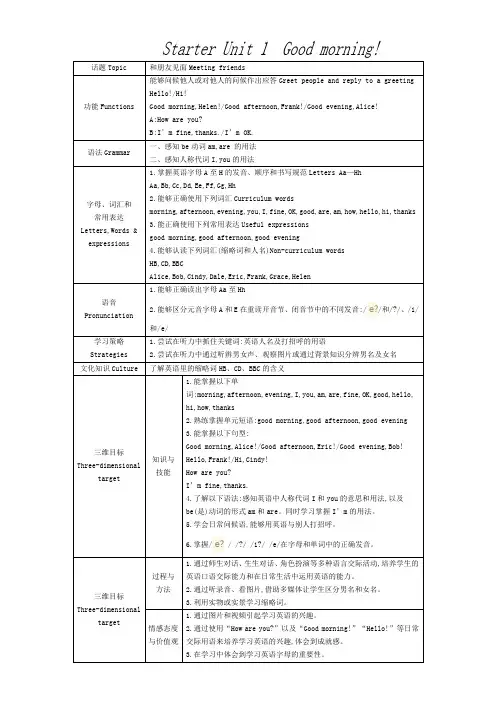
Starter Unit 1 Good morning!1.熟练地运用各时间段的问候语和应答,如:Hi!/Hello!/Good morning./Good afternoon./Good evening./How are you?I’m fine,thanks.2.掌握字母A-H 的发音、顺序和大小写。
学习元音字母A 、E 在重读开音节、闭音节中的发音。
学会总结和归纳发音规律。
3.感知英文人名的特点,能够区分男、女名。
通过观察图片、感知图片中的语境,结合听力录音,培养学生的语言感知能力,并能流利地用英语互致问候。
让学生准确模仿读音,学会字母的规范书写。
教学突破:突出听力和口语表达,训练问候语,感知、分辨男名、女名,运用问候语的重点句型,培养学生听、说的能力。
读准字母,熟悉并能分辨字母的印刷体和书写体。
注重方法与价值观的培养:听说练习,大量感知英语,加强输入,养成良好的学习英语的习惯。
口语练习采用Pair work 和Group work 相结合的方式,多多练习,学会合作。
引导学生积极参与口头表达活动,正确运用英文名字。
要求在日常生活中关注英语字母构成的物品,猜测词意。
学会总结、归纳字母A 、E 在重读开、闭音节中的读音情况,找到适合自己的学习方法。
第一课时: 1a-2e第二课时: 3a-4d第一课时1a—2e1.记忆字母Aa,Bb,Cc,Dd,Ee,Ff,Gg,Hh;单词good,morning,hi,hello;短语 good morning;缩略词HB,CD,BBC。
2.掌握问候语Good morning!Hi!Hello!并能运用英语名字与人打招呼。
3.通过观看图片和多媒体展示的方式进行听力和口语训练,通过师生合作、生生合作、小组合作、角色扮演的方式,学会在情景交际中练习语言点,训练英语听说技能。
用卡片、大小写配对及顺序接龙的方式学习字母。
4.创设愉快的学习氛围,培养学生学习英语的兴趣。
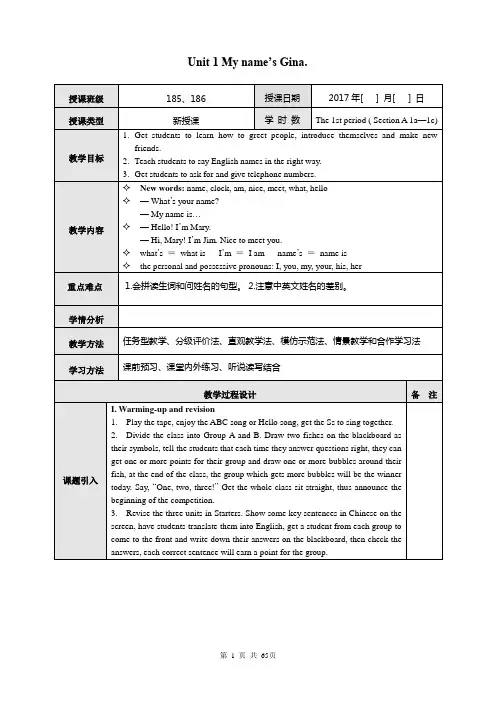
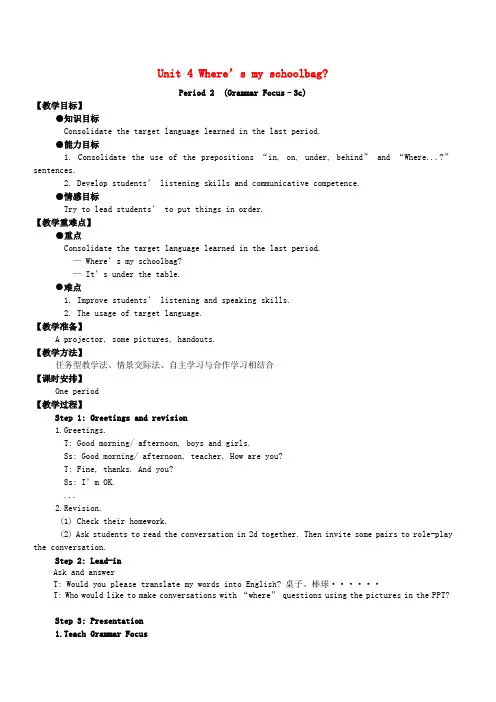
Unit 4 Where’s my schoolbag?Period 2 (Grammar Focus–3c)【教学目标】●知识目标Consolidate the target language learned in the last period.●能力目标1. Consolidate the use of the prepositions “in, on, under, behind” and “Where...?”sentences.2. Develop students’ listening skills and communicative competence.●情感目标Try to lead students’ to put things in order.【教学重难点】●重点Consolidate the target language learned in the last period.—Where’s my schoolbag?—It’s under the table.●难点1. Improve students’ listening and speaking skills.2. The usage of target language.【教学准备】A projector, some pictures, handouts.【教学方法】任务型教学法、情景交际法、自主学习与合作学习相结合【课时安排】One period【教学过程】Step 1: Greetings and revision1.Greetings.T: Good morning/ afternoon, boys and girls.Ss: Good morning/ afternoon, teacher. How are you?T: Fine, thanks. And you?Ss: I’m OK....2.Revision.(1) Check their homework.(2) Ask students to read the conversation in 2d together. Then invite some pairs to role-play the conversation.Step 2: Lead-inAsk and answerT: Would you please translate my words into English? 桌子、棒球······T: Who woul d like to make conversations with “where” questions using the pictures in the PPT?Step 3: Presentation1.Teach Grammar Focus(1)Ask students to read the sentences in the box in Grammar Focus.(2)Invite some students to explain their meanings.(3)Place a schoolbag, a pencil box and a set of keys where all students can see them.(4)Ask students to make conversations in turn like this:S1: Where is the schoolbag?S2:It’s...S1: Where is the pencil box?S2:It’s...S1: Where are the keys?S2:They’re...(5) Leave students several minutes to do this work.(6) As they work, move around the room, checking progress and offering help as needed.(7) Invite some pairs to act out for the whole class.2. Teach activity 3a(1) T: Let’s work on 3a. Look at the pictures in 3a. Please fill in the blanks to complete the conversations.(2) Check the answersT: Have you finished? Please check your answers with your classmates.Answers: 1. A: Where are the keys? B: They’re on the table.2. A: Where’s the book? Is it on your desk? B: No, it’s under the chair.3.A: Where are the pencils? B: I don’t k now. Are they in the schoolbag? A: Yes, they are.(3) First ask students to read the conversations together then ask some students to read the conversations for the class.Step 4: Practice1. Teach activities 3b(1) Ask students to look at the pictures in 3b.T: What can you see in the pictures?(2) Invite students to answer answer the question.(3) Put students into pairs to make conversations like this:S1: Where are the books?S2: They are on the sofa.S1: Where’s the pencil?S2: It’s in the pencil box....(4) Leave students several minutes to do this activity.(5) Let some pairs to act out the conversations in front of the class.2.Teach activity 3cGame: Find the differences(1) T: Now it’s time for a game. Let’s play the game in pairs. Student A looks at the picture on this page. Student B looks at the picture on page 19. What do you find?(2) T: Yes, the two pictures are similar. But there are still some differences between them. Try to find out the differences by asking and answering questions.Example: T: Where’s the pencil box? Is it on the table?A: No, it isn’t. It is in the schoolbag.(4) T: I am sure you are clear about what to do. Let’s see who can find all the differences first. Let’s start!(5)Invite some pairs to present their conversations in pairs.Step 5: Consolidation(1) Put some things in different places. Ask students to say something about them like this: S1: Where is the schoolbag?S2: It’s on the desk.S1: Is it on the desk?S2: Yes, it is.S1: Is it under the desk?S2: No, it isn’t. It’s on the desk.(2) Leave students enough time to do this practice.(3) As they work, move around the room, checking the progress and offering help as needed. 【课堂小结】In this period, we’ve consolidated what we’ve learned in the last period through some practice and games.【课后作业】1. Read the sentences in Grammar Focus.2. Make some conversations by yourself.3. Preview the next period.。
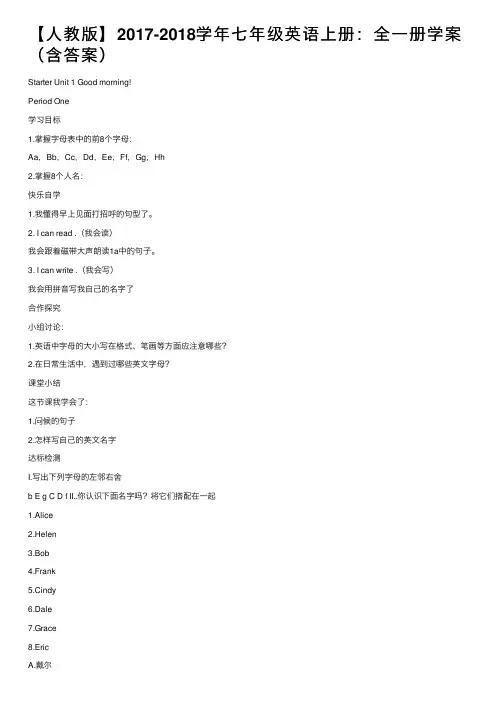
【⼈教版】2017-2018学年七年级英语上册:全⼀册学案(含答案)Starter Unit 1 Good morning!Period One学习⽬标1.掌握字母表中的前8个字母:Aa,Bb,Cc,Dd,Ee,Ff,Gg,Hh2.掌握8个⼈名:快乐⾃学1.我懂得早上见⾯打招呼的句型了。
2. I can read .(我会读)我会跟着磁带⼤声朗读1a中的句⼦。
3. I can write .(我会写)我会⽤拼⾳写我⾃⼰的名字了合作探究⼩组讨论:1.英语中字母的⼤⼩写在格式、笔画等⽅⾯应注意哪些?2.在⽇常⽣活中,遇到过哪些英⽂字母?课堂⼩结这节课我学会了:1.问候的句⼦2.怎样写⾃⼰的英⽂名字达标检测I.写出下列字母的左邻右舍b E g C D f II..你认识下⾯名字吗?将它们搭配在⼀起1.Alice2.Helen3.Bob4.Frank5.Cindy6.Dale7.GraceB.艾丽斯C.海伦D.⾟迪E.弗兰克F.埃⾥克G.格雷丝H.鲍勃III.从II栏中找出与I栏相应的答句I II( )1.Good morning! A.Good evening! ( )2.Hi, Ann! B.Good morning!( )3.Good afternoon! C.Hi, Tom! ( )4.Good evening! D.Good afternoon! IV.补全对话1.-________________, Helen!-Good morning, Cindy!2.-Hi, Bob.-________________, Alice.3.-Good evening!-_______________!V.单项选择( )1.早上或上午见⾯说:“_______”A.Good morning!B.Good afternoon!C.Good evening!( )2.熟⼈之间打招呼时应说:“_______”A.Hi!B.Good morning!C.Good afternoon!( )3.傍晚遇见你的好朋友说:“_______”A.Good morning!B.Hi!C.Good evening!B.Good morning, Eric!C.Good evening, Eric! 学习反思答案:I. a b c D E F f g h B C D C D E e f gII.1-8. BCHEDAGFIII.1-4.BCDAIV.1. Good morning2.Hello/Hi3. Good eveningV.1-4.AACAStarter Unit 1 Good morning!Period Two学习⽬标1.掌握字母表中的前8个字母:Aa ,Bb ,Cc ,Dd ,Ee ,Ff ,Gg ,Hh2.掌握3个新单词:HB ,CD ,BBC快乐⾃学1. I can listen .(我会听)我会听录⾳并跟读2a2. I can finish .(我会完成)我能根据2b 听录⾳,根据所听到的顺序为字母编号。
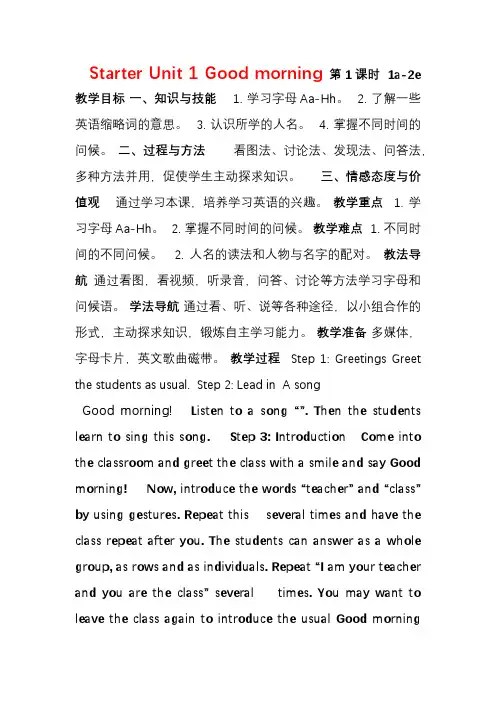
Starter Unit 1 Good morning 第1课时 1a-2e 教学目标一、知识与技能 1. 学习字母Aa-Hh。
2. 了解一些英语缩略词的意思。
3. 认识所学的人名。
4. 掌握不同时间的问候。
二、过程与方法看图法、讨论法、发现法、问答法,多种方法并用,促使学生主动探求知识。
三、情感态度与价值观通过学习本课,培养学习英语的兴趣。
教学重点 1. 学习字母Aa-Hh。
2. 掌握不同时间的问候。
教学难点 1. 不同时间的不同问候。
2. 人名的读法和人物与名字的配对。
教法导航通过看图,看视频,听录音,问答、讨论等方法学习字母和问候语。
学法导航通过看、听、说等各种途径,以小组合作的形式,主动探求知识,锻炼自主学习能力。
教学准备多媒体,字母卡片,英文歌曲磁带。
教学过程 Step 1: Greetings Greet the students as usual. Step 2: Lead in A songGood morning!Listen to a song “”. Then the students learn to sing this song. Step 3: Introduction Come into the classroom and greet the class with a smile and say Good morning! Now, introduce the words “teacher” and “class” by using gestures. Repeat this several times and have the class repeat after you. The students can answer as a whole group, as rows and as individuals. Repeat “I am your teacher and you are the class” several times. You may want to leave the class again to introduce the usual Good morning routine. Say Good morning, class. Helpthe students respond with “Good morning.”. Point to yourself and say: I’m Miss/Mr. ... Have them repeat. Explain the terms Miss and Mr. in Chinese. Repeat this a few times with rows and individuals. Miss, Mr. ... (The students repeat.) Morning, Miss/Mr. … (The students repeat.) Good morning, Miss/Mr. ... (The students repeat.) Step 4: Practice Say: Stand up, please! with gestures. (The students stand up.) Leave the classroom, return and say: Good morning, class! Help the students respond with “Good morning, Miss/Mr. ...” Say: Sit down, please. Now let’s start the lesson. Step 5: Listen and repeat Say Open your books, turn to page S1. There are 8 students in the picture.(按图片上的人物数) One, two, three, four, five, six, seven, eight. Their names are: Grace, Bob, Dale, Helen, Eric, Frank, Cindy and Alice. (可以通过大屏幕展示第S1页上的彩图,然后再展示单张图片,并分别与名字相对应。
Starter Unit 1 Good morning!Period 1 (1a–2e)【教学目标】●知识目标1. Learn to read and write letters Aa--Hh.2. Master the greeting sentences: Good morning. Hello/Hi!.3. Learn the meaning of some abbreviations.●能力目标Be able to greet each other using the target language.●情感目标Try to develop students’ interests in English and educate students to be polite.【教学重难点】●重点1. Learn to read and write letters Aa--Hh.2. Be able to greet each other using the sentences: Good morning/afternoon/evening. Hello/Hi!●难点Be able to greet each other using the target language.【教学准备】A tape recorder, some word cards, pictures and handouts.【教学方法】任务型教学法、情景交际法、自主学习与合作学习相结合【课时安排】One period【教学过程】Step 1: GreetingsThe teacher wears a name card with an English name on it, then points to the name card and makes a self-introduction.T: Welcome to my class. I’m your new teacher,... What’s your name?Give students several minutes, and invite every student to stand up to do a self-introduction for the whole class....Step 2: Lead-inListen to the ABC song.T: This is our first class. We’ll learn how to greet each other simply. Before learning, let’s listen to a song.Play the tape of the ABC song first, and ask students to listen carefully. Pay attention to the pronunciation and intonation.Then play it again, asking students to repeat after the song.Later, sing the song together.Step 3: Presentation1. Teach activity 1a(1) Ask students to open their textbooks, look at the picture carefully and find out the answers to the following questions:What can you see in the picture?How many students are there in the picture?What are they doing?Provide students with several minutes to think about the questions.(2) Read the conversation. The students listen and repeat.T:As we know, there are eight students in the picture.Who are boys, and who are girls? Write down their names on the lines.(3) Ask students to do this activity individually, and then check the answers.Answers:Boys’ names: Bob, Dale, Frank, EricGirls’ names:Grace, Helen, Cindy, Alice2. Teach activity 1b(1) Play the recording for the first time, and ask the students to pay attention to the pronunciation and intonation.(2) Play the recording for the second time. Ask the students to listen and repeat.(3)If students can’t listen to the conversation clearly, play it one more time.3. Teach activity 1c(1) Ask the students to practice the conversations in pairs. Move around the class when the students are practicing. Give them some help if needed.(2) Role-play the conversations in 1a in pairs.(3) Ask the students to practice greetings each other. They can use their Chinese names if they wish. Encourage them to use their English names if they can. Ask them to practice using all the different greetings taught in 1a.(4)Ask several pairs to act out their conversations for the whole class.4. Teach activity 2a(1)Show the 8 letters Aa--Hh on the screen, and teach students to read them one by one.(2)Play the tape, and ask students to pay attention to the pronunciation and repeat.(3)Invite some students to read these letters, and correct their pronunciation mistake if there is any.5. Teach activity 2bT: Now I’ll play the record. You’ll hear eight letters. Listen carefully andnumber the letters you hear.(1)Play the tape, ask students to finish activity 2b individually.(2)Play the tape again, ask students to check their answers.(3)Check the answers with the whole class.6.Teach activity 2c(1)Teach students how to write these big and small letters.(2)Ask students to copy the letters in their exercise books.Step 4: Practice1. Teach activities 2d(1) Ask students to read the letters in 2d and make sure they can read all the letters correctly.(2) Ask students to write letters Aa--Hh after the models. At the same time, ask one boy and one girl to write on the blackboard. While students are working, move around the room, checking progress and offering help if they needed.(3) Check the answers. Correct mistakes if any.2. Teach activity 2e(1) Show the pictures in 2e on the blackboard.(2) Ask students to read aloud the letters.(3) Choose a picture, and ask the students to say the abbreviations.T:What can you see in the picture?(picture one)S1:I can see a pencilT:Very good. Do you know the meaning of the letters below the picture? What does HB mean? Who knows?S2:It means hard black.T:Excellent....(4) Encourage the students to say more abbreviations and explain their meanings.Step 5: Consolidation1. Put students in pairs, and ask them to greet each other like this:S1: Hi!S2:Hello!S1:Good morning, S2.S2:Good morning, S1.As students work, move around the classroom and offer help if needed.Finally, ask some pairs to act out the conversations.2. Show the cards of the eight letters in disorder, and ask students to read the letters one by one correctly.Then, get students to work in pairs. One takes pictures, the other reads the letters. Do it in turns.【课堂小结】In this period, we’ve learned how to greet when we meet in the morning. And we’ve also learned how to read and write letters Aa--Hh, as well as some abbreviations.【课后作业】1. Listen and recite letters Aa--Hh.2. Recite the conversations in 1a.3. Copy these eight big and small letters five times.。
Unit 4 Where’s my schoolbag?Period 4 (Section B 2a–Self Check) 【教学目标】●知识目标1. Master the new words and useful expressions.2. Master the target language.●能力目标1. Be able to grasp the main idea of the article.2. Be able to describe where things are.3. Develop students’ reading and writing competence.●情感目标Educate students to be tidy and put things in order.【教学重难点】●重点1. Master the new words and useful expressions.Words: tidy, but, our, everywhere, always2. Be able to grasp the main idea of the article.3. Be able to describe where things are.●难点Develop students’ reading and writing competence.【教学准备】The text book and handouts.【教学方法】任务型教学法、情景交际法、自主学习与合作学习相结合【课时安排】One period【教学过程】Step 1: Greetings and revision1. GreetingsT: Good morning, everyone.Ss: Good morning, teacher. How are you?T: Fine, thanks. And you?Ss: I’m OK.2. RevisionReview what we learned in the last period.Step 2: Lead-inT: We have finished most of Unit 4. And in this period, we will continue to finish Section B. But before that, I would like you to review what we learned before.Step 3: Presentation1. Teach activity 2a(1) T: Now, we’ll do some writing practice.(2) Ask students to have a look at the picture.T: Which place is it?Ss:It’s a room.T: What can you see in the picture?S1: I can see two beds, a desk, a chair and a sofa.T: Great. Anything else?S2: I still can see a clock, some books and a schoolbag.T: OK. Write down the words you know for the things. Do it individually. Finally, I’ll check your answers.(3) Leave the students three minutes to do this activity, and check the answers later.2. Teach activity 2b(1) T: Now. Read through the instruction so that you can know how to do this activity.(2) Read the passage and answer the questions: Is Kate tidy? Is Gina tidy?T: Let’s move to the activity 2b. Would you please look read the passage and answer the two questions?(3) Check the answers.T: I think most of you have finished. Please read the passage with your partners and check your answers together.(4) Read. First, ask the students to read the passage together. Then, invite some of them to read it for the class.3. Teach activity 2c(1) Ask students to read through the instruction of this activity so that they can know how to do it.(2) Leave students two minutes to do this task individually. Move around the classroom to check the progress and give some help if necessary.(3) Invite some pairs to check their answers.Answers:Step 4: Practice1. Teach activities 3a(1) T: Let’s work on 3a. First, have a quick look at the instruction and the chart in 3a so that you can know how to do this activity.(2) Ask students to complete the chart individually.(3) Leave students several minutes to do it.(4) Check the words and the phrases you know.T: Do you have these things? Where are they?T: I would like all of you to read the words and the phrases together.2. Teach activity 3b(1) T: Write about where the things are in your room. Use the word and if you can. Please ask your classmates for help. Looking up the words in a dictionary is also a good way to study English.I hope you can get more from dictionaries.(2) Leave students several minutes to do this task.(3) As they work, move around the room, checking progress and offering help as needed.(4) Collect students’ notices. Choose the best ones to present to the whole class.Step 5: ConsolidationTeach Self Check1. Self Check 1(1) T: We’ve learned many things in our rooms. Now first review all the things in three minutes. Then let’s have a competition. We’ll write the things you can remember in a piece of paper. Let’s see who can remember the most.(2) Students review the words of the school things quickly. Then have a competition.(3) Check the numbers of the words on their paper to see who does the best.2. Self Check 2(1)T: We’ve also learned how to talk about the location of some objects in this unit. Let’s look around our classroom. What can you see in our room? Where are they?(2) Ask students to find out these things and write about the locations like the sample sentence. Then ask them to complete the chart individually.(3) Check the answers.【课堂小结】In this period, we’ve mainly further consolidated how to talk about where things are through a passage. And we’ve also done some writing practice to consolidate what we’ve learned in this period.【课后作业】1. Review the new words and useful expressions in this period.2. Read the messages again and again in 2b.3. Finish the exercises on the workbook.4. Preview the next unit.。
Unit 4 Where’s my schoolbag?Period 1 (Section A 1a–2d)【教学目标】●知识目标1. Master the new words and useful expressions.2. Master the target language.3. Master the use of the prepositions “in, on, under, behind”and “Where...?”sentences.●能力目标1. Be able to make conversations using the target language.2. Be able to describe the location of the objects.●情感目标Lead students to form a good living habit.【教学重难点】●重点1. Master the new words and useful expressions.Words: where, table, bed, bookcase, sofa, chair, on, under, come, desk, think, room, their, hat, head, yeahExpression: come on2. Master the use of the prepositions “in, on, under, behind” and the target language:—Where’s my schoolbag?—It’s under the table.3. Improve students’ listening and speaking skills.●难点1. Be able to talk about the location of the things.2. Master the use of the prepositions “in, on, under, behind”and “Where...?”sentences. 【教学准备】A tape recorder, some pictures, some school things and handouts.【教学方法】任务型教学法、情景交际法、自主学习与合作学习相结合【课时安排】One period【教学过程】Step 1: Greetings and revisions1. Greeting the students.T: Good morning! /Hello!/ Hi! ...Ss: Good morning! /Hello!/ Hi! ...2. RevisionT: What’s this in English?S1: Can you spell it?T: Yes, thank you. You are very good. What are these in English?S2: They are keys.T: Can you spell it?S: Yes, K-E-Y-S, keys.Step 2: Lead-inT: Last week, we finished Unit 3. Today we are going to study a new unit, Unit 4.Ask and answerT: Can you tell me what the title of Unit 4 is? Yes, it’s “Where’s my schoolbag?” What do you think the unit is about?T: Great! In this unit, we are going to learn to talk about where things are. Do you still remember some school things we have learned?T: What are they? OK. Let’s start to talk about some school things first.Step 3: Presentation1. Teach activity 1aT: First, please open your books to page 19 and look at activity 1a.(1) Look and findT: Please look at the picture in activity 1a. There are some things in it. Do you know what they are?(2) Match and discussT: Would you please match the words with the things in the picture?T: How many words do you know? Can you share the words you know with your partners?T: Please discuss with your partners and check whether your answers are the same.(3) Check the answersT: Let’s check the answers together.Answers: 1.table b 2.bed e 3.bookcase h 4.sofa g 5.chair d 6.schoolbag a 7.books f 8.keys c(4) ReadFirst, ask students to read the words after the teacher. Read each word twice then ask students to read the words one by one together.2. Teach activity 1b(1) Ask students to listen to the recording for the first time. Students number the things in the picture when you listen.(2) Play the recording for the second time. Ask students to write answers by themselves.(3) Invite some students to check the answers. Then play the recording for the third time. Havestudents listen and repeat, pay attention to the pronunciation and intonation.Answers: 1.books 2.pencil box 3.computer game 4.keys3. Teach activity 1c(1) Lead students to read the conversations in 1a. Ask them to pay attention to the pronunciation and intonation.(2) Explain the languages points in the conversations.(3) Ask students to read the sample conversation in 1c. Encourage them to make their own conversations using the given words in the box.(4) Leave them several minutes to do this task in pairs.(5) Invite some pairs to act out their conversations for the whole class.Step 4: Practice1. Teach activities 2a(1) Go through the instruction in 2a with the class.(2) Look at the pictures in 2a.(3) Play the recording for the first time. Students listen and number the things.(4) Play the recording for the second time. Let students check the questions they hear, then check the answers.Answers: 2.books 6.keys 1.computer game 5.ruler 3. pencil box 4.schoolbag2. Teach activities 2b(1) Go through the instruction in 2b with the class.(2) Look at the pictures in 2b carefully.(3) Play the recording for the first time and tell students to only listen to them carefully.(4) Play the recording for the second time. Ask students to find the things in 2a and number them in the picture.Ask them to do it individually.(5) Then check the answers.Answers: 1.computer game in the bookcase2.books on the chair3.pencil box under the sofa4.schoolbag under the table5.ruler under the chair6.keys on the table(6) Play the recording for the third time. And let students listen and repeat.3. Teach activity 2c(1) Ask the students to read through the conversations in pairs.(2) Give them three minutes to practice reading it.As students work, walk around the room, offering help if necessary. Correct pronunciation mistakes if any.(3) Ask several pairs to act out their conversations.Step 5: ConsolidationTeach activity 2d1. Ask students to read the conversation by themselves to get the main idea.2. Lead students to read the conversation sentence by sentence, and explain some language points at the same time.3. Play the recording, and ask students to listen and repeat. Then ask them to role-play the conversation in pairs. Move around the classroom to check the progress.4. Invite several pairs to role-play the conversation for the whole class.【课堂小结】In this period, we’ve learned how to talk about the location of things through some listening and speaking practice. And we’ve also learned the use of “Where...?”question and the prepositions of location.【课后作业】1. Review the new words and useful expressions in this period.2. Practice the conversation in 2d in pairs and recite it.3. Finish the exercises in the workbook.4. Preview the next period.。
Starter Unit 3 What color is it?Period 1 (1a–2d)【教学目标】●知识目标1. Learn to read and write the letters Ss--Zz2. Master the new words and expressions:color, red, yellow, green, blue, black, white, purple, brown●能力目标Be able to talk about colors.●情感目标Lead students to learn the meaning of different colors and appreciate the beauty of colors.【教学重难点】●重点1. Learn to read and write the letters Ss--Zz.2. Master the new words and expressions.3. Be able to talk about colors.●难点1. To learn the letters Ss--Zz.2. Be able to talk about colors.【教学准备】A tape recorder, multi-media, some letter cards and some color pens.【教学方法】任务型教学法、情景交际法等相结合【课时安排】One period【教学过程】Step 1: Greetings1. Greet the students in English.T:Good morning, class.Ss:Good morning, teacher. How are you?T:I’m fine, thanks. How are you?Ss:I’m OK.2.Review letters I--RT: Can you say the letters from I to R?Ss:Yes. I, J, K, L, M, N, O, P, Q, R.Step 2: Lead-in1.Show a picture of a rainbow to teach different colors.T:This is a rainbow. It’s colorful. (Point to the color red.) It’s red. (Point to the color yellow.) It’s yellow...2.Show some real things with different colors to learn the words: red, yellow, green, blue, black, white, purple, brown.T: Look at the flower. It’s a red flower. Read after me, “red”.Ss: Red, red, red.T:What color is it?Ss: It’s red....3.Show some colorful letter cards to the students and practice.T:What’s this?Ss: It’s V.Teacher: What color is it?Ss: It’s ......Step 3: Presentation1. Teach activity 1aT: Look at the picture in 1a carefully and tell me what you can see then.S1:There are five students.S2:There are some balloons with different letters on it.T:Letters? Are they alike?S2: No, they aren’t. They are in different colors.T:Great! Can you match the words with the colors? Please write the letter for each color on the line next to each word.Do it individually, and then I’ll check your answers.(While the students are doing, the teacher moves around to help the ones who need help.)2. Teach activity 1b(1) Play the tape for the first time. Students only listen.(2) Play the tape for the second time. Students listen and repeat.(3) Ask some students to repeat the conversations.(4) Explain the differences between “this” and “that”.3. Teach activity 1c(1) Ask the students to practice the conversation in pairs.(2) Put the students in pairs. Ask them to make their own conversations using the things in the picture.(3) Leave them several minutes to do this activity.(4) Invite some pairs to act out their conversations.4. Teach activity 2a(1)Show the 8 letters Ss--Zz on the screen, and teach the students to read them one by one.(2)Ask students to listen to the tape and read after it.(3)Teacher shows some letter cards and invite some students to read these letters, correcting their pronunciation mistakes if there is any. .5.Teach activity 2b(1)Play the tape for the first time. Students listen.(2)Play the tape for the second time. Students listen and number the letters.(3)Play the tape for the third time. Students listen and check their answers.Step 4: Practice1. Teach activities 2c~2d(1)Present the letters Ss--Zz on the PPT.(2)Remind students the writing forms of the capital letters and small letters.(3) Ask students to write the letters Ss--Zz after each model. At the same time, ask two students to write on the blackboard.(4) While students are writing, move around the room, checking progress and offering help if needed.(5) Check the answers. Correct mistakes if any.2. Teach activity 2e(1)Show the letters and the meanings the students know.(2)Show the pictures in 2e on the screen.T:What can you see in the picture?(the first picture)S1:Three big letters S, M and L.T:What do these letters mean?S2:S stands for small, M for medium and L for large.T:Right....(3)Add some more abbreviations, such as:XL(加大号),MTV(音乐电视),IT(信息技术),IQ(智商),EMS(邮政速递公司),SARS(非典),RMB(人民币),PC(个人计算机)and so on.Step 5: ConsolidationPlay a game.(1)Do the color changes game, use two small cups of water, and color each cup of yellow and blue. Ask and answer like this:T:What color is it?S1:It’s yellow.T: What color is it?S2:It’s blue.(2)After asking, pour the cup of yellow water into the other cup. When the water turns green, ask students, “What color is it now?”(3)Do the color changes with other colors.【课堂小结】In this period, we’ve learned how to talk about colors and the letters Ss--Zz. And we’ve also learned some new words and useful expressions.【课后作业】1. Listen, read and recite letters Aa--Zz2. Copy letters Ss--Zz three times.3. Read and copy the words on S9.。
Starter Unit 1 Good morning!Period One学习目标1.掌握字母表中的前8个字母:Aa,Bb,Cc,Dd,Ee,Ff,Gg,Hh2.掌握8个人名:快乐自学1.我懂得早上见面打招呼的句型了。
2. I can read .(我会读)我会跟着磁带大声朗读1a中的句子。
3. I can write .(我会写)我会用拼音写我自己的名字了合作探究小组讨论:1.英语中字母的大小写在格式、笔画等方面应注意哪些?2.在日常生活中,遇到过哪些英文字母?课堂小结这节课我学会了:1.问候的句子2.怎样写自己的英文名字达标检测I.写出下列字母的左邻右舍b E g C D f II..你认识下面名字吗?将它们搭配在一起1.Alice2.Helen3.Bob4.Frank5.Cindy6.Dale7.Grace8.EricA.戴尔B.艾丽斯C.海伦D.辛迪E.弗兰克F.埃里克G.格雷丝H.鲍勃III.从II栏中找出与I栏相应的答句I II( )1.Good morning! A.Good evening!( )2.Hi, Ann! B.Good morning!( )3.Good afternoon! C.Hi, Tom!( )4.Good evening! D.Good afternoon!IV.补全对话1.-________________, Helen!-Good morning, Cindy!2.-Hi, Bob.-________________, Alice.3.-Good evening!-_______________!V.单项选择( )1.早上或上午见面说:“_______”A.Good morning!B.Good afternoon!C.Good evening!( )2.熟人之间打招呼时应说:“_______”A.Hi!B.Good morning!C.Good afternoon!( )3.傍晚遇见你的好朋友说:“_______”A.Good morning!B.Hi!C.Good evening!( )4.当别人对你说Hello, Frank!你应说:“_______”A.Hello, Eric!B.Good morning, Eric!C.Good evening, Eric! 学习反思答案:I. a b c D E F f g h B C D C D E e f gII.1-8. BCHEDAGFIII.1-4.BCDAIV.1. Good morning2.Hello/Hi3. Good eveningV.1-4.AACAStarter Unit 1 Good morning!Period Two学习目标1.掌握字母表中的前8个字母:Aa ,Bb ,Cc ,Dd ,Ee ,Ff ,Gg ,Hh2.掌握3个新单词:HB ,CD ,BBC快乐自学1. I can listen .(我会听)我会听录音并跟读2a2. I can finish .(我会完成)我能根据2b 听录音,根据所听到的顺序为字母编号。
d b c f3. I can guess .(我会猜)我能根据口形,猜出同伴所演示的字母.4. I can dictate.(我会默写)我会默写这8个字母了。
5.我懂得2e 中字母HB ,CD ,BBC 所组成的缩写形式的含义了。
合作探究小组讨论:1.英语中字母的大小写在格式、笔画等方面应注意哪些?2.在日常生活中,我们除了知道HB,CD,BBC这些缩写词外,还遇到过哪些?课堂小结这节课我学会了:1.8个字母的大小写2.并知道3个缩写词达标检测I、在所学字母中,我学会了两个元音字母:II、写出所学字母中由三笔完成的大写字母:III、写出所学字母中由一笔完成的小写字母:IV、完成下列单词的缩写形式:1.(铅笔芯)硬黑2.光盘3.英国广播公司学习反思答案:I、Aa EeII、ABFHIII、c eIV、1.HB 2.CD 3.BBCStarter Unit 1 Good morning!Period Three学习目标1.掌握8个新单词:how, are, you, I, am, fine, thanks, OK.2.掌握下列句型:(1)-How are you?-I’m fine,thanks.(2)-How are you?-I’m OK.快乐自学1. I can remember.(我会记)我能背出字母的前八个字母及重要的问候语。
2. I can finish. (我能完成)我能跟录音完成3a3 . I can read.(我会读)我会与同伴练习3a中的对话。
4. I can write.(我会写)怎样,怎么你,你们是,我好的 thanks= 谢谢好,不错I’m=5. I can make sentences.(我会造句)我会用所学的8个新单词造3个句子:你身体好吗? ?我身体好,谢谢。
.我很好。
.6. I can listen. (我会听)我能听完录音后,听对话,并与同伴练习3c中的对话,从而巩固我新造的3个句子。
7. I have my English name. (我有英语名字了)根据1a,我选了一个我最喜欢的英语名字,并和同伴一起用新选的英语名字,互相问候,完成3d 的任务。
合作探究小组讨论:1.good,fine和OK的用法之别。
2.在哪些场合我们常用thanks来回答。
3.I’m fine.和I’m OK.都可以用来回答How are you吗?课堂小结这节课我学会了:1.这节课我学会了Words(单词):缩写形式:Senten ces(句子):达标检测完成下列对话,每空一词。
1.- afternoon,Dale!- , Bob!2..- are you?- , thanks. How you?-I’m .学习反思答案:1.Good ,Good afternoon2.. How,I’m fine,are ,fine/OKStarter Unit 1 Good morning!Period Four学习目标1.掌握2个新单词:name, list2.复习本单元所学的字母,单词及句型。
快乐自学1. I can write.(我会写)我能完成以下内容。
谢谢。
你好吗?三种回答方式 1. 2. 3.2. I can finish.(我能完成)我能朗读4c中第一栏的字母和单词,并并读出第二栏生词。
3. I can sing.(我会唱)我会唱4d中的歌曲Good morning! Good afternoon! Good evening!Good morning! Good afternoon! Good evening!How are you? How are you? How are you?I’m fine, thanks. I’m fine, thanks. I’m fine, thanks. How are you? How are you? How are you?I’m OK. I’m OK. I’m OK.合作探究小组讨论:1.小组操练:小组操练本单元所课后的几个句型。
2.小组讨论:我们学会了元音字母A和E发音的哪些基本规则。
课堂小结这节课我学会了:(1)words(单词):。
(2)8个字母:(3)句型有:达标检测一、我叫D ale,我在上午、下午、晚上分别遇到了Eric,Fra nk和Bob,下面是我和他们见面时的对话,每空一词。
1.- ,Eric!- , !2.- ,Frank!- ,Dale!3.- ,Bob!- ,Dale!二、编对话我(Bob)和好朋友Helen下午在回家的路上遇到了,我们互相问候,并询问身体状况,请把我们的对话写出来,不少于五个句子。
-----学习反思答案:一、1. Good morning!,Good morning!, Dale!2. Good afternoon!!,Good afternoon!3. Good evening!,Good evening!二、编对话我(Bob)和好朋友Helen下午在回家的路上遇到了,我们互相问候,并询问身体状况,请把我们的对话写出来,不少于五个句子。
Bob - Good afternoon!!,HelenHelen- Good afternoon!!,BobBob - How are you?Helen - I’m fine, thanks.And you?Bob - I’m OK.Thank you.Starter Unit 2 What’s this in EnglishPeriod One学习目标1.掌握15个新单词及两个完全形式和缩写形式:what , is , this , in , English , it , aan , map , orange , jacket , key , quilt , pen , ruler,what’s = what is , it’s=it is2.掌握下列句型:(1) -what’s this in English?-It’s an orange.(2) -What’s this in English?-It’s a jacket.3.掌握不定冠词a和an的用法。
快乐自学1. I can read.(我会读)我能在1a中找到学习目标1中的新单词并会读,并能完成1a的任务。
2.I can write.(我会写)我能根据图中对话,和小伙伴伙伴编写新对话。
3.I can conclude.(我会总结)通过对话,我能总结a和an的用法之别,并能用a和an填空了。
(1)There is(有)“h” in the word(单词)“how”.(2)I h ave (有) apple(苹果).(3)There is “g” in the word “good”.(4)It is pen.4.I can act.(我会表演)通过学习1a中的对话,我能和同伴一起操练句型并表演。
-What’s this in English?-It’s an orange.-What’s this in English?-It’s a jac ket.5.我是小作家.通过操练上述对话的内容,我能用身边的学习用品及其它物件编写新对话。
(1) --(2) --合作探究小组讨论:1.小组讨论不定冠词a和an的用法之别。
2.如果问句中的主语是this,答句用it作主语来回答,对吗?3.我们学习了I am,what is,it is的缩写形式,那么this和is可以缩写成th is’s吗?课堂小结I’ve learned in this class(这节课我学会了):新单词、短语、句子达标检测I、翻译下列句子,每空一词。